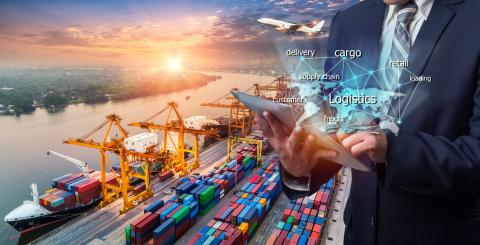Retailers move from a supply chain to a value chain mindset
The majority of retail leaders (89%) consider the complexity and diversity of today's supply chain risks to be one of the largest threats to corporate growth, according to Capgemini Research. In light of these changes, retail executives are transforming their supply chains from a simple functional system to a holistic, integrated network focused on value creation.
Retail Leader and RIS News talked with industry leaders focused on the value chain —- Justin Honaman, Amazon Web Services’ head of worldwide retail and consumer goods go-to-market; Guy Yehiav, president of SmartSense by Digi; and Matt Laukaitis, SAPS’s executive vice president and global general manager of consumer industries — to provide insight into the evolution of the supply chain function from cost-center to value-creator.
Retail Leader (RL) and RIS News (RIS): How would you define the value chain?

Justin Honaman: The value chain for a retailer starts with the upstream supplier, which is usually a consumer goods brand like Coke, Pepsi, Mars, Nestle, Kellogg or a maker of clothing in fashion apparel, and then it ends typically with the purchase of that product to a consumer.
Guy Yehiav: The value chain is an inclusive framework for describing the economic and material benefits that products carry during every step of the lifecycle — raw material production, component manufacturing, product manufacturing, assembly, transportation, retailing, merchandising, point of purchase and point of consumption. The value chain includes the whole process, with supply and demand working in tandem. Additional value is created by moving products through the chain. For food purchased at a grocery store, the value chain starts with growers producing the ingredients for food. The process starts with the “end in mind” — consumption by people eating food. For electronic manufacturing, the start of the value chain could be when the necessary metals are produced. Examples of the consumption of electronic manufacturing are when sensors are used in an internet of things network and when consumers use their personal electronic devices.

Another way of defining value chain is to say that it is equal to a Demand Driven Supply Network (DDSN). The implementation of DDSNs became popular in the late 1990s as companies looked to balance supply more closely with demand and reduce costs associated with sitting on aging inventory. Operators who adopted DDSN shifted their perspective from supply networks to “outside in" demand networks, taking into account historical demand data, demand generation tactics such as pricing adjustments and promotion campaigns, and geographic location of demand. By shifting the focus to identifying demand first and then working to manipulate it, operators revealed the value chain and demonstrated the gains associated with movement through the stages.

Matt Laukaitis: A value chain refers to all the activities involved in a business process, starting from design and production to marketing, distribution, delivery and after-sales services. The goal of value chain management is to facilitate communication among different stages of the value chain to ensure a smooth and efficient process of delivering the product or service to customers. This includes minimizing any delays or obstacles that may occur, with the aim of making sure the product is getting in the hands of customers as seamlessly and as quickly as possible.
As business processes become more complex and powered by more technology and innovation, the concept of a value chain has become an important evolution driving companies to generate efficiencies and optimize profitability. This is especially important as retailers evolve to include more and more focus on experiences as part of their customer journey, and the timing, velocity, scale and composition of the individual elements of the value chain take on more meaning. For example, providing a product that is linked to a customer experience like a new bicycle as part of an adventure trip the customer purchases together from the same retailer. In many cases, retailers are adding new participants to an ever expanding value chain, so it is important to be able to manage and orchestrate all of these individual relationships.
RL and RIS: How are retailers shifting from a supply chain mentality to a value chain mindset?
Laukaitis: Retail companies are balancing the impact of global disruption and the need for a resilient supply chain. With so much choice at their fingertips, consumers expect more than ever before; ultra-convenience, flawless service and seamless experiences are now foundational to brand loyalty. Simultaneously, the global supply chain is experiencing stress, and retailers must continually adapt to shipping delays, higher delivery costs and fluctuating consumer demands.
In the current business landscape, companies are actively reconsidering their approaches to optimize processes and guarantee efficient and sustainable product delivery to customers. This shift is rooted in a broader goal of eliminating the traditional division between front-office and back-office operations. Instead, businesses are aiming to create a unified and comprehensive experience that enables customers to effortlessly access data from any point in the supply chain. The integration of real-time data visibility plays a crucial role in the future of value chain management, where the emphasis moves beyond cost efficiency towards building resilience and promoting sustainability.

It’s also important to underscore the fact that the value chain does not stop when the customer buys the product. With today’s ability to understand the overall relationship and the lifetime value that the customer enjoys with their purchase, retailers are finding new ways to stay relevant all throughout the lifecycle, including re-commerce, exchange and return/resale.
Yehiav: This shift has been a large effort since the early 1990s. One can identify if a retailer has a supply chain mentality or value chain mindset by the way they answer the question, ‘Where does your supply chain start?’ If they say it starts at the shelf, they’re demand-driven with a value chain mentality. If they talk about when the truck comes or other transportation logistics, warehousing, etc., they’re thinking supply first. More and more retailers are moving to a demand-driven approach for their business, adding value to their customers and aligning with ever-changing customer demands while maintaining a better P&L on their books.
Honaman: Supply chain is a broad topic that typically includes inventory, logistics, distribution and warehousing. When we think of the value chain, you have constituents that are suppliers that lead up into your supply chain and then you have constituents that are your end customer after the supply chain part of the process. Supply chain is one element of the value chain.
This September 25-27, RL and RIS are joining forces to debut Value Chain Tech, a new event in Seattle focused on the technologies that power the key pillars of value chain success: agility, resiliency, collaboration and sustainability.

72cf.jpg)
